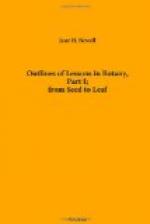The root, on the contrary, grows only from a point just behind the tip. The extreme tip consists of a sort of cap of hard tissue, called the root-cap. Through a simple lens, or sometimes with the naked eye, it can be distinguished in most of the roots of the seedlings, looking like a transparent tip. “The root, whatever its origin in any case may be, grows in length only in one way; namely, at a point just behind its very tip. This growing point is usually protected by a peculiar cap, which insinuates its way through the crevices of the soil. If roots should grow as stems escaping from the bud-state do,—that is, throughout their whole length—they would speedily become distorted. But, since they grow at the protected tips, they can make their way through the interstices of soil, which from its compactness would otherwise forbid their progress."[1]
[Footnote 1: Concerning a few Common Plants, p. 25.]
The third difference is that, while the stem bears leaves, and has buds normally developed in their axils, roots bear no organs. The stem, however, especially when wounded, may produce buds anywhere from the surface of the bark, and these buds are called adventitious buds. In the same manner, roots occasionally produce buds, which grow up into leafy shoots, as in the Apple and Poplar.[1]
[Footnote 1: See Gray’s Structural Botany, p. 29.]
It should be made perfectly clear that the stem is the axis of the plant, that is, it bears all the other organs. Roots grow from stems, not steins from roots, except in certain cases, like that of the Poplar mentioned above. This was seen in the study of the seedling. The embryo consisted of stem and leaves, and the roots were produced from the stem as the seedling grew.
For illustration of this point, the careful watching of the cuttings placed in water will be very instructive. After a few days, small, hard lumps begin to appear under the skin of the stem of the broken seedling Bean. These gradually increase in size until, finally, they rupture the skin and appear as rootlets. Roots are always thus formed under the outer tissues of the stem from which they spring, or the root from which they branch. In the Bean, the roots are in four long rows, quartering the stem. This is because they are formed in front of the woody bundles of the stem, which in the seedling Bean are four. In the Sunflower the roots divide the circumference into six parts. In some of my cuttings of Beans, the stem cracked in four long lines before the roots had really formed, showing the parenchyma in small hillocks, so to speak. In these the gradual formation of the root-cap could be watched throughout, with merely a small lens. I do not know a better way to impress the nature of the root on the pupil’s mind. These forming roots might also be marked very early, and so be shown to carry onward their root-cap on the growing-point.




